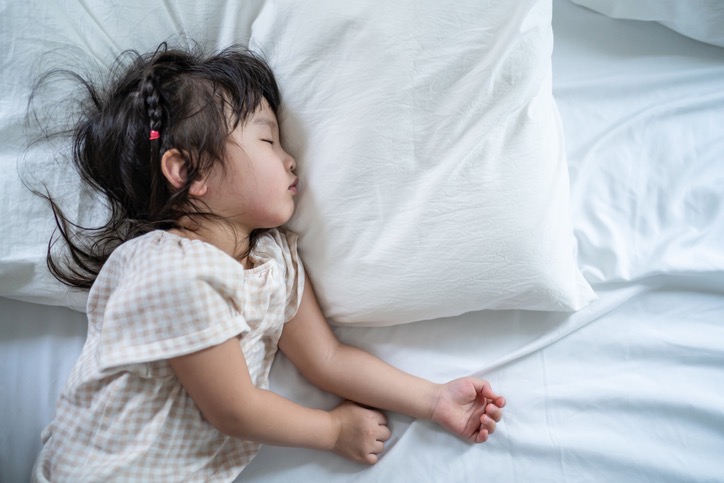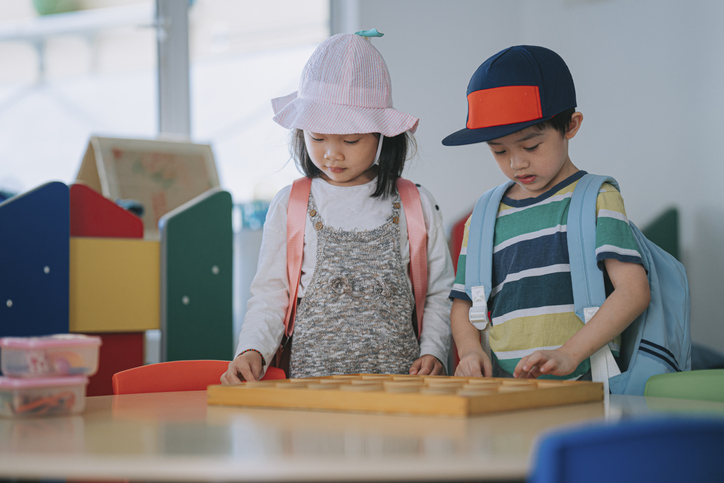A Preschool Teacher’s Tips for The Big First Day!

Your child’s first day of Pre-K is a big deal. It is particularly overwhelming for young children who have never attended childcare or didn’t stay home with a nanny or caregiver while their parents worked. For many children, preschool is their first experience with being away from home for more than a few hours.
Many children are excited to start preschool, but even those who are excited may experience first-day jitters and separation anxiety. I spent fourteen years teaching preschool, so if this is your little one’s first time attending child care or preschool, here are a few of my top suggestions to make the big day exciting, memorable, and smooth!
1. Create a "Goodbye Routine," and Don't Linger
A Goodbye Routine is a trusted and true way to help both you and your child say goodbye and start the day on a positive note. Sometimes, parents can be just as anxious as their children, so a goodbye routine can set the tone for a great first day.
A goodbye routine can involve various steps, or it can be simple. If you need some inspiration, ask your child’s preschool teacher for ideas. Here is a basic goodbye routine I used with my son:
1. Give a Hug
2. High-Five
3. Tell them to have a great day and let them say the same to you
4. Say goodbye with a wave and walk out the door!
You mustn't linger once you’ve said goodbye because this can confuse your child, and the more you linger, the longer your little one may want you to stay.
If your child has trouble with separation anxiety or saying goodbye, talk with your child’s teacher about a hand-off: this is where you pass your child to the same teacher every day. This process creates routine and stability for your child. Some settings implement this themselves, with specific children being assigned a ‘key person’ who is in charge of tracking their developmental milestones and keeping an eye on their well-being. Another option is to take them to a favorite play center or engage them in a favorite activity before saying goodbye.
If your child cries, it is essential to reassure them that you love them and that you will be back, but state that it is time for you to go and that they are safe here at school with (teacher’s name). Then, hand them off to the teacher, give them one more kiss and hug and then say goodbye and leave.
Whatever you do, do not sneak out and do not come back into the room if you hear your child crying. Coming back only establishes the pattern that if your child cries, you will stay, and trust me when I tell you, it will only get worse, and they will cry longer and louder the next time. On the flip side, sneaking off creates uncertainty and breaks trust when your child realizes you are suddenly gone and can make future goodbyes more challenging.
It is heartbreaking to see or hear your child cry; I know, I’ve experienced it from both the parent and the teacher's side, but I can assure you within a matter of minutes, the tears disappear, and your child will be engaged with their new friends. If you need reassurance, call and check in about 10-15 minutes later or ask the teacher to give you a call.
2. Write a Nap Time Note

Nap time notes were a tradition the first teacher I worked with used, and it was something I loved and tried in subsequent classes. If it is not an established routine in your child’s classroom, ask their teacher if you can leave a note to be read at nap time as they settle in for sleep.
A note from home can help your child feel secure and safe in their new environment. You could also leave a note in their lunch box to be read at lunchtime. A note from home may be a tradition that only lasts the first week or so, or it may be something that continues into kindergarten and even first grade.
3. Go Back-to-School Shopping Together
Everyone loves back-to-school shopping, even little kids. So while most preschool classrooms come stocked with crayons, paper, and other school supplies - no teacher or daycare is likely to say no to classroom donations!
But beyond classroom supplies, your child can pick out some new outfits, a backpack to carry their nap supplies, a lunchbox, and maybe even some new shoes!
Keep in mind children in preschool get messy. Between potty training, art projects, and playing outside, this isn’t the time for designer clothing. Additionally, it is wise to stock their cubby with at least two complete changes of clothes in case of accidents and spills.
4. Create a Family Book
A family book is an excellent way to help children with separation anxiety. A family book can include photographs of family members or pets, or even drawings that your child has created.
The family book should stay in your child’s cubby or backpack so that they can take it out and look at it when they feel a little anxious or sad, or even so that they can show it off to their friends!
If the school allows so, ask if you can tape pictures of your family to your child’s cubby; most classrooms love displaying family pictures!
5. Build Excitement for the Big Day

Build excitement for the start of the school year weeks ahead by talking about it, reading books about school, playing games, and allowing your child to express any concerns or questions they have.
Establish a morning routine a few weeks before school starts to prepare everyone for the new normal. Rushing around that first day will only make everyone feel anxious.
If possible, visit the school before the big day. Most early childhood centers and preschools will set up playdates where the child can visit the classroom for an hour or two during the school day while mom or dad hangs out elsewhere in the building.
If your child is attending a Pre-K or preschool program through a public school that doesn’t run year-round, attend any events held before the start of the school year, such as “Meet the Teacher” or “New Student Orientation.”
Another way to ease nerves is by engaging your child in pretend play where they get to be the teacher!
Lastly, no matter how anxious you are, don’t let your child see! They will notice this and pick up on your anxiety. Instead, be excited and make lots of positive statements about school. Starting school should be a positive and fun experience for parents and children, so enjoy this time by recognizing and celebrating what a big step the first day of preschool is!

